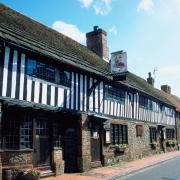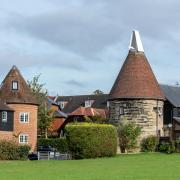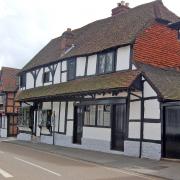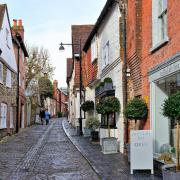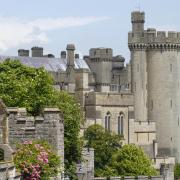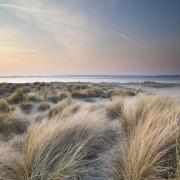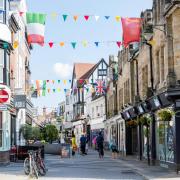Battle lines are being drawn between mother and daughter at this year’s South of England Show, as Duncan Hall discovers
As the South of England Show celebrates its Year of the Sheep, the livestock show is set to host a battle across the generations.
Based on their 600-acre family farm in Offham, near Lewes, Susan Harmer and her husband Justin have been coming to the show for the last 36 years, winning multiple trophies as the Supreme, Reserve and Interbreed champions over the years. In the months before the show their children Lizzy, Edward and Gussie have all helped get their sheep and other livestock ready.
But for the first year the now-married Lizzy, 25, will be bringing some of her own sheep to go up against her 48-year-old mother’s champions marking the sixth generation of the family to farm the Southdown sheep breed.
Getting Susan’s sheep show-ready takes a lot of preparation. “Choosing the right rams is of great importance,” she says in a break from the lambing season. “The pregnancy should go smoothly with no problems or stress in order to guarantee the best lambs are born. As soon as they are born we look for all the right characteristics in order to select our top show lambs.”
The Southdown sheep flock she brought to the farm when she got married was started by her father Paul Wakeham-Dawson in 1980. “Being a Sussex farming man he recognised how well-suited the native Southdown breed were to the type of grazing we have here at Mill Laine Farm. The Southdown can thrive in most conditions and still put on weight, even on tighter or poorer grazing.”
When it comes to finding the right sheep to show Susan knows exactly what she’s looking for. “I judge at various shows so I have seen some of the best specimens in the breed. The qualities we look for are a nice broad back, high tail, strong sound legs – one in each corner, like a box – streamlined bellies and as much enhancement to the back end as possible. They must have good muscle form and structure, mouse-brown legs and nose, and the distinctive dark Southdown T-shape on the nose must be perfect. We like to see a nice amount of thicker leg wool, some fine wool on the ears, lovely pink skin with no dark marks and an all-round strong and healthy animal.”
Trimming the sheep before the show is an important part of getting them ready – and the Harmers use traditional methods to get them looking their best. Mother and daughter will be putting aside their rivalry for a joint trimming demonstration as part of the weekend.
“We like to wash and trim our shearlings just once, but really well, one or two weeks before the show,” says Susan. “It’s quite a skill to trim the Southdown. We use hand shears and carders to get the fleece as even and box-like as possible.”
The right treatment of the sheep is essential to create a champion. Susan’s Southdown sheep are grazed on the hills above Lewes, on land which is registered as a site of Specific Scientific Interest. The land isn’t treated with fertilisers or chemicals, but is carefully managed with water levels closely monitored. In winter the sheep and cattle are fed on cereals, hay and straw which have all been produced on the farm.
Some 100 years ago 110,000 Southdown sheep roamed the Downs, but the numbers have since dropped dramatically to 3,000. But Susan is optimistic for the future of what she describes as a “serious commercial breed” which produces rams for the sheep industry to rival any elsewhere in the country or on the continent. “It’s a wonderful breed for smallholders,” she adds. “The Southdown is fold-tolerant [meaning they don’t escape] and they are easy to handle. Obviously we are breeding on a larger scale than most and to encourage others to breed Southdown we are always looking at ways to improve what we do here in Offham.”
The Southdown sheep breed produces a very tender meat – but this wasn’t always the case. “It did have a reputation in the past of being a bit fatty,” says Susan. “With the investment of monitoring and technology we have now managed to produce a much leaner meat without losing its wonderful flavour. It makes sense to breed leaner as it takes five times more energy to produce a kilo of fat than a kilo of lean meat in a growing animal, so it should be much more appealing in terms of business for farmers.”
That use of technology extends to how the family monitors the lambing process. “We have all our ewes pregnancy-scanned to get the feeding correct for the number of lambs expected,” she says. “The pedigree Southdown lambs are also Signet recorded [a service for farmers providing genetic evaluations to identify sheep and cattle with superior breeding potential] and back scanned to show performance trait such as muscle, fat depth and growth rates, helping to select the highest performing lambs for breeding.” Susan selects two ram lambs and two ewe lambs very early on and ensures they are fed well and looked after carefully for showtime. At the South of England Show she will be available to chat about her work with the Southdown breed as well as the different breeds of sheep, cattle, pigs and goats that come to the show.
“The show offers us a wonderful shop window for our native breeds,” she says. “It is always a fantastic few days where we get together with friends and colleagues from across the industry. We are able to have time out of farm life and show off our much-loved animals.”
As well as looking after her flocks in all weathers – following strict management, welfare and assurance standards – Susan and Justin also run the Offham farm shop, which sells meat from the farm including Sussex beef, Southdown lamb and pork from their Welsh pedigree pigs. There are plans to expand the shop, and build another grain store as the farm’s arable production is increased. Susan says the farm is also adding a new pig unit and planning to expand ewe numbers.
“We are excited and hopeful that we can continue to improve and enjoy many years to come at the farm.”
The annual livestock show, which also features hundreds of beef and dairy cattle, pigs and goats, is just part of the 49th South of England Show, which returns to the South of England Showground, in Ardingly, from Thursday, 9 June to Saturday, 11 June.
And as well as celebrating the Year of Sheep in 2016 the South of England Agricultural Society is marking the Queen’s 90th birthday.
Among the attractions are the 32m high Ardingly Eye – offering a bird’s eye view of the 150-acre showground in 24 enclosed glass gondolas with a capacity of six people each. With 70,000 visitors heading down last year, there are plenty of arena displays on top of the craft and shopping stalls, and the giant food hall selling local and regional dishes. One of the highlights is the Royal Signals White Helmet motorcycle display team, who will be performing death-defying stunts in the main ring.
Horse-lovers can watch the Shetland Pony Grand National on Friday and Saturday, as well as an equestrian showcase featuring more than 1,500 horses and ponies over three days. Harveys Brewery is bringing its heavy horses to a new Harveys Heavy Horse Village and Cask Ale Pub. And dogs are celebrated with displays of the foot packs on Thursday, a parade of hounds on Friday and parade of foxhounds on Saturday. Also new this year is a music stage featuring up and coming performers from across Sussex and Kent. Further competitions over the weekend include the Young Craftsman of the Year, traditional horse-shoeing and the new Racing Bug interactive game in the Motoring Zone.
www.seas.org.uk/south-of-england-show
READ ON
• Why the South Downs National Park is the perfect place for any Instagram addict - Whether you live in Sussex or are here for a visit, the South Downs National Park really is a must-see part of this beautiful county. As these pictures prove...
• Sussex walk with views of the South Downs and Devil’s Dyke - Enjoy wonderful views of the South Downs and the Devil’s Dyke in this circular stroll










